Abstract
This paper deals with how AI can summarize issues emerging from the newly developing confrontation between Texas and the US Federal Government regarding unrestricted migration across the southern US border. The paper shows how AI embedded in the Mind Genomics platform can provide a mechanism whereby a person can profoundly explore subjective thinking about a topic. The paper presents the verbatim result of an easy-to-understand, easy-to-do, and very affordable investigation, one which required less than 36 to conceptualize, implement, understand, and ‘work up’ for publication. The combination of Mind Genomics and AI in the user-friendly Idea Coach promises a new capability to democratize critical thinking, world-wide.
Introduction
Since the informal opening up of the southern US Border, the news sources have been filled with innumerable accounts of migrants coming across the border and escaping into the United States. The issues involved in this wholesale unwanted, unplanned for and frankly dangerous entrance of hordes of strangers into the US has erupted into conflicts between states and now a conflict between the state of Texas and the US Federal Government. The issue is so grave that the government in Texas is announcing that it will maintain its protective system of wires, in defiance of the United States Federal Government. As one might expect, the issues are so important, so severe that within the past month alone (January 2024) dozens of treatments of the issue have appeared in Google Scholar, remarkable for a topic [1-6]. The sheer volume of published material on the topic, the continuing ‘buzz’ of the social media, the incessant reporting by today’s media giants, and the unspoken concerns of the ordinary citizen suggest the need for a better way to understand the topic. It is to address that need that this paper was written, more from the desire to see how far AI could go to help the citizen ‘understand’, as well as how far AI could go to make a scholar contribution to civil society. This ‘experiment in AI’ looks at the situation from the point of view of what might be called the ‘Mind of Texas’. The underlying structure of the AI study is to present the situation, then suggest that there are different mind-sets about this topic, mind-sets from the point of Texas, but not to name these mind-sets. Rather, the AI is instructed to name the mind-set, state what the mind-set believes to be the proper action, how does the mind-set support that belief, and then assign a rating to the strength of the case that Texas is making with that mind-set.The important thing to keep in mind is that the effort represents a new way of thinking about AI and political issues. Rather than summarizing information to answer a specific question, AI is tasked with identifying new to the world groups, not given anything. Furthermore, for each group, the AI is tasked with finding out how they think, and finally and most uniquely, estimating the strength of the argument.
The Contribution of Mind Genomics and the Impetus of AI to Solve the Problem of Critical Thinking
The origin of the material reported here can be traced to the emerging science of Mind Genomics, colloquially the ‘science of the everyday’. The inspiration for Mind Genomics was the desire to understand how ordinary people thought about the ordinary events of their day, the granular aspects of their quotidian existence to put in a way which may have more gravitas. Cognitive psychology recognizes that people make decisions in different ways but focuses on the person making the decisions rather than on the specific topics about which the decisions are made. Mind Genomics works with combinations of elements, these elements being simple descriptions of aspects of a thing or a situation. The combines these elements into small vignettes, combinations of elements, doing so according to a scheme which prescribes the precise combinations. Respondents, or in other disciplines so-called ‘survey-takers’ then read each vignette and rate the vignette, that combination of messages. The respondent may read several dozen vignettes, one vignette at a time, and then rate the vignette on a scale. Once the data are collected, the researcher deconstructs the rating assigned to the vignette into the part-worth contribution of each of the elements. To the respondent the task is simple, although often boring. The elements are combined in different ways for the respondents, so that each respondent evaluates a different set of vignettes. The mathematical structure of the vignettes is the same form one respondent to the other. The only thing which changes is the particular set of combinations. This ability to give people different combinations of the same elements, but in reality the underlying structure is the same, is a feature of Mind Genomics. When doing the task the respondent, having been presented with these seemingly random combinations, stops trying to figure out the ‘underlying game’, stops trying to outguess the researcher, and ends up simply guessing, which turns out to be what was desired in the first place. The happy result is that the way the respondent thinks about the topic ends up being revealed by statistics (OLS or ordinary least-squares regression). The system works because it mimics nature. Nature continues to present to us vignettes, combinations of simple stimuli. In order to survive we have to pick out through this blooming, buzzing confusion in the words of the eminent 19th century Harvard psychologist, William James. The desire to understand how different elements drive the response is attractive to researchers because these elements possess ‘meaning.’ When the researcher presents combinations of phrases to the respondent, the combination does signify something, and elicits a responses, even though the combinations may be put together in what seems to be a random way. When the researcher combines the phrases according to an underlying ‘experimental design’ which specifies the particular combinations, there is nothing in the design which forces a coherent meaning. Yet, for the most part, respondents have no problem finding meaning in the combination. When asked to rate the combination, the vignette, most respondents may be at first perplexed about what to do, but within one or two exposures the respondents cease being perplexed and go about the task of reading and rating the vignettes. The behavior is almost like ‘grazing’ for meaning. That is, the respondent looks at the vignette, extracts the information needed to decide, assigns a rating and moves on. From literally thousands of studies following the use of prescribed experimental designs and inexperienced panelists who don’t know what to do, the data which emerge makes sense. What appeared to be a random set of combinations, perhaps even a different set for each respondent, all combinations, all vignettes constructed by design quickly gives way by regression analysis to a clear picture of what specific messages ‘drive’ the response. The data are often clear even with the whole panel whose individuals may possess different points of view. The pattern emerges. When the data from the panelists is analyzed by clustering, the different points of view end up being separated into mind-sets, clusters of people showing different patterns of elements which drive the responses. The foregoing has presented a short history of a growing science, beginning in the world of food [7], beginning with commercial issues, soon morphing inexorably to issues of social importance, whether that be society, ethics and morals, just to name a few [8]. Over time Mind Genomics thinking further expanded its reach into the law [9], education [10] and medicine [11] continuing to do so today, as will be shown by the study discussed here.
The Introduction of AI to the World of Systematic Experimental Design of Ideas
The migration of research away from simple surveys to the evaluation of mixtures of messages was introduced to th research world in 1993, at the annual ESOMAR research congress, held in Copenhagen, Denmark [12]. The interest by market research companies was awakened, and a number of companies licensed the technology, which was run on a PC, and required local set up, but had automatic analysis. The one continuing issue in the licensing business was the need develop the messages. Although the researchers were familiar with qualitative research (REF), the task of developing meaningful messages ‘on demand’ and for different topics began to stress the researchers, and in turn their clients. The requirement to develop a specific set of messages for a topic, messages with substance, proved harder to fulfill than simply creating a questionnaire with general ideas (e.g. how important is XYZ?) The problem of developing elements to put into the system continued to plague the growth of Mind Genomics, even though with experience most practitioners felt comfortable developing the requisite set of messaging. Over time the Mind Genomics system developed into a templated process. The user was instructed to assign the study a name, to think of four questions which tell a story, and then for each question to think of four answers. Figure 1, Panel A shows the request to provide four questions which tell a story. Creating a template helped the process of coming up with messages, although users of the program, www.BimiLeap.com, often reported that being confronted with the empty template and a request to provide questions was unnerving. Once the user developed the questions, however, providing answers became far less stressful. It became increasingly clear that the ability to think in a creative fashion seemed to have diminished, at least for the development of questions which ‘told a story.’ At the same time, it became obvious that people with little experience rarely complained about providing answers to questions that they had developed or that were posed to them by someone else. The introduction of artificial intelligence in 2022 through Chat GPT provided a breakthrough. The use of AI had been already demonstrated several years before [13]. The task was detailed, and not sufficiently quick, certainly not the ‘turnkey’ process, although for its time the process proved excellent. What was need was a turnkey system. Chat GPT by Open AI [14] provided that system, one that was incorporated into the BimiLeap platform, which supported the now more mature science of Mind Genomics. AI was introduced in the form of a tool called Idea Coach, which required the user to write out the problem (Figure 1, Panel B), which would then result in the return of 15 questions. The process could be repeated, the expression of the problem could be edited, and the process could be repeated ad infinitum. Idea Coach allowed the user to select questions, populate the template, and then do the same thing to create each of the four answers, to each o the four questions. In other words, the Idea Coach embedding AI made the process faster.
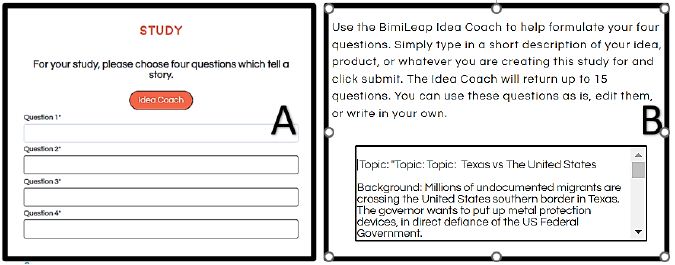
Figure 1: The templated request for four questions (Panel A), and the box where the user can communicate the request to AI embedded in the Idea Coach (Panel B).
Moving Beyond Questions and Answers to AI as a Deeper Guide to Critical Thinking
The initial use of Idea Coach focused on creating questions, then answers to the questions, and finally doing the ‘experiment’ with real people after having selected the four questions, and the 16 answers (elements). Over time, however, the appeal of AI grew, along with the unexpected discovery that AI would generate more when the squib (Figure 1, Panel B) was given more detail instructions, and asked to play a greater role. Table 1 shows what happens when the request for questions is replaced by a composition about a topic, specifically the issue of the Texas border. The input to the AI is far deeper, far more extensive. Table 1 shows a virtual briefing, requiring AI to carry out specific actions and exhibit critical thinking. The initial experience with this approach simply requested AI to identify mind-sets, rather than simply to prepare a set of questions. Some months later the request for AI was far deeper, with many more levels. The ability to request answers with ‘critical thinking’ became a newly discovered benefit in the Mind Genomics platform. It was easy to put together these ‘squibs’ to put into the Idea Coach. Once the squib was created the user needed only to request one iteration after another, with the AI in Idea Coach returning with either new results, or occasionally excuses why the request could not be fulfilled anew, even though the request had just been fulfilled three times, each time with different types of answers .As a second benefit, it was quite easy to switch to an edit mode, revise the squib and try again, a capability which led to a half a dozen to two dozen iterations and edits in a matter of 30 minutes.
Table 1: The request to AI to provide ‘critical thinking’ about the border issue between Texas the US Federal Government.
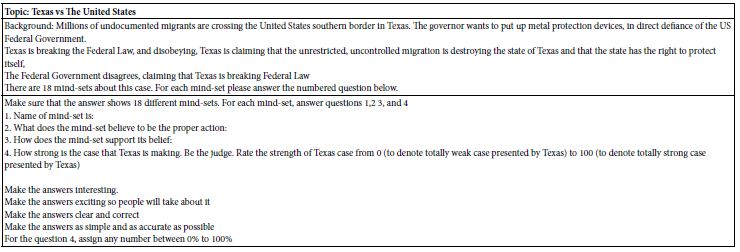
Table 2 shows the unexpected outcome. The request to the AI was to identify 18 different mind-sets, and to answer four questions (name of mind-set; believed ‘right action’, support for belief; numerical estimate of the strength of case). No other information was provided to the AI in Idea Coach. Yet, with 20 seconds of the request, the following set of 16 mind-sets (not the requested 18) was provided. The mind-sets may or may not be accurate. What is impressive, however, is both the speed at which this request was fulfilled, and the quite deep nature of the request, including the totally unexpected assignment of scores for the strength of the, or here really the ‘strength of the opinion in a court of law.’ Whether or not these conjectured mind-sets are correct is not relevant for right now. The important thing to keep in mind is that the AI allows the user to begin to think in a new manner. Rather than stranding the user with questions which require the user to enter into a potentially stressful situations, viz., required to produce ideas, the Idea Coach produces material which engages the user in a dialog. The user can discuss the conjectures produced by the AI. The AI is becoming a tutor. What is even more interesting is the ‘seeming’ ability of AI to produce estimates of the strength of the different arguments held by the mind-sets, as shown by the rating of the ‘Strength of Texas’ case’, ranging from a high of 90% (Mind-Set #6; The State’s Rights Advocate) to a low of 15% (Mind-Set #16; The Free Movement Advocate). The reasons for the ratings of strength of argument are not know, but the numbers themselves can serve as springboards for discussion.
Table 2: The 16 returned mid-sets, showing the name of the mind-set, information about the attitudes of the mind-set, and the hypothesized strength of the Texas argument, as estimated by the AI tool.
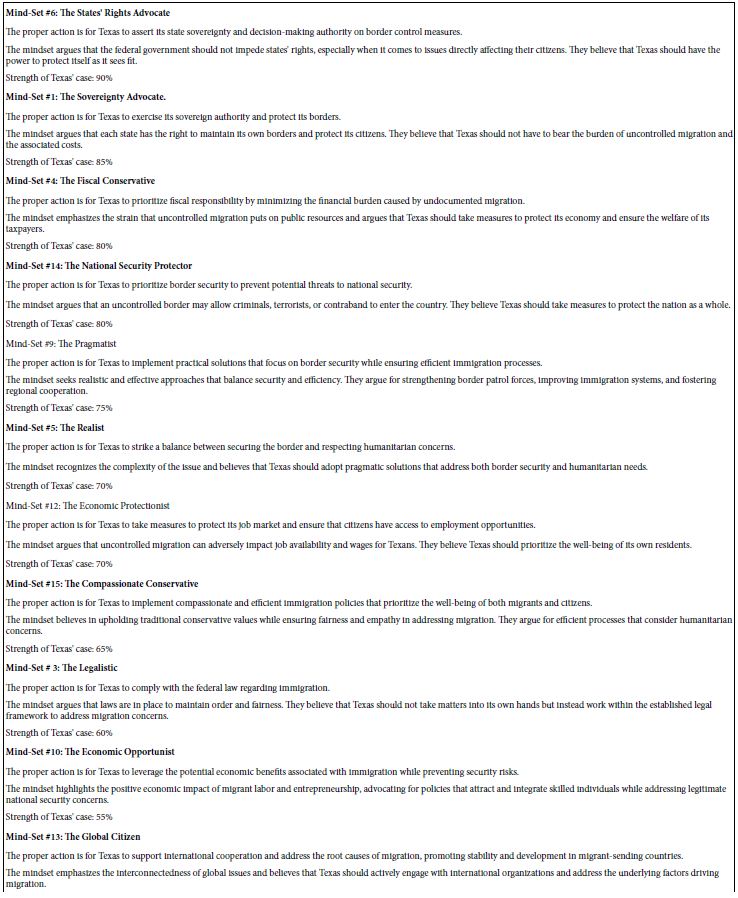

The Idea Coach has been programmed to provide a detailed summarization of the information at the end of the iteration. Once the steps are completed which create the ‘questions’ and ‘answer’ (viz., silos or categories and their elements) the Mind Genomics platform assembles all the iterations, and for each iteration summarizes that iteration using a series of questions. The summarized material, including that shown in Tables 1 and 2, is returned by email in an Excel file. Each tab of the Excel file corresponds to a different iteration.
First Set of Summarizations – Viewpoints and Audiences
Summarization 1 is alterative viewpoints. For this effort, the Idea Coach returned with five general viewpoints, looking at the problem of migration from a variety of points of view. The Alternative viewpoints are general in nature. Once again the alternative viewpoints are presented in descending order of strength for Texas’ case. Summarization 2 describes ten different groups who would be interested in the topic, and why specifically they would be interested in the topic. Summarization 3 describes six different groups who would be opposed to dealing with the topic for their own specific reasons. Once again it is obvious that the AI produces seemingly ‘reasonable’, ‘thought-out’ analyses. Even if the analyses are incorrect, they serve as a springboard for discussion. Once again it is important to keep in min that these summarizations are done quickly, inexpensively, and can be done at an ‘industrial-scale’ to produces specific ‘knowledge’ on virtually any topic (Table 3).
Table 3: Three different ways of approaching the issues, by considering the topic from the mind of the person. These three ways are alternative viewpoints (general viewpoints), interested audiences (the topic is interesting to discuss), and opposing audiences (the topic is not of interest to them, and they would rather see the topic ‘shelved’ or otherwise eliminated.)
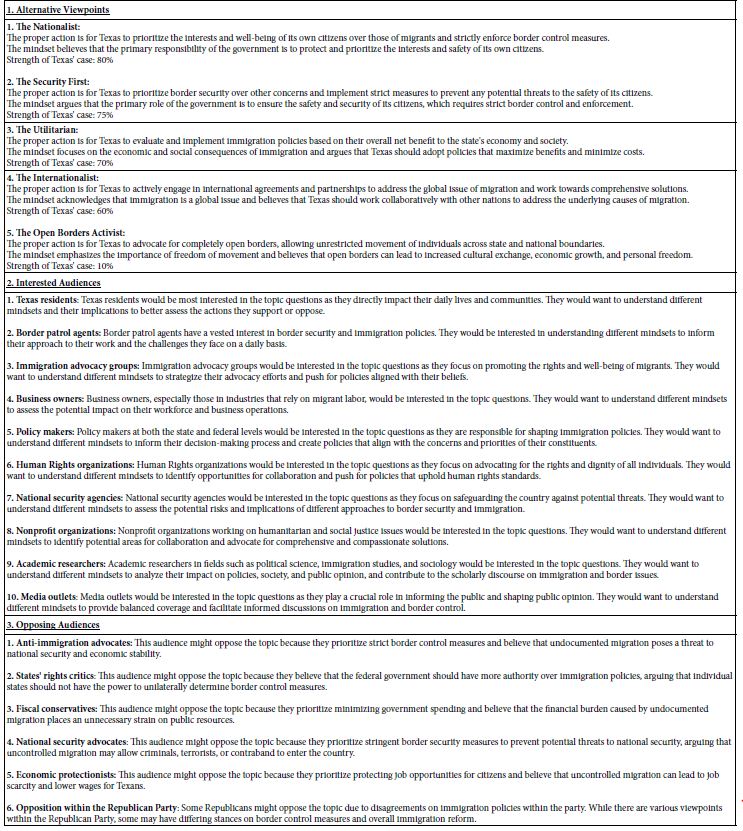
Second Set of Summarizations – Ideas, Themes, Perspectives
This second set of summarizations focuses on the different ideas which emerge from the AI deep thinking, or deep simulation. The first summarization deals with the key ideas emerging from the exercise. The AI embedded in the Idea Coach takes the set of suggestions (questions, proposal of mind-sets), analyzes the text, and returns with the different basic ideas. In this way the summarization pulls together the different points into what could be a smaller set of more general ideas. The second summarization, themes, further reduces the information almost to a summary of the summary. The third summarization, perspectives, moves from reducing the ideas to expanding the ideas into points that can be discussed. At this point the AI has taken the user through ideas, through reducing the ideas to a limited set, and then having digested the information returns with points for further discussion (Table 4).
Table 4: Three different ways of sharpening the ideas. Key Ideas show the topics extracted from the different mindsets. Themes further reduce the information to a small set of general ideas. Perspectives challenge the reader to rethink the topic with greater insight, presenting arguments, both the pros and the cons.
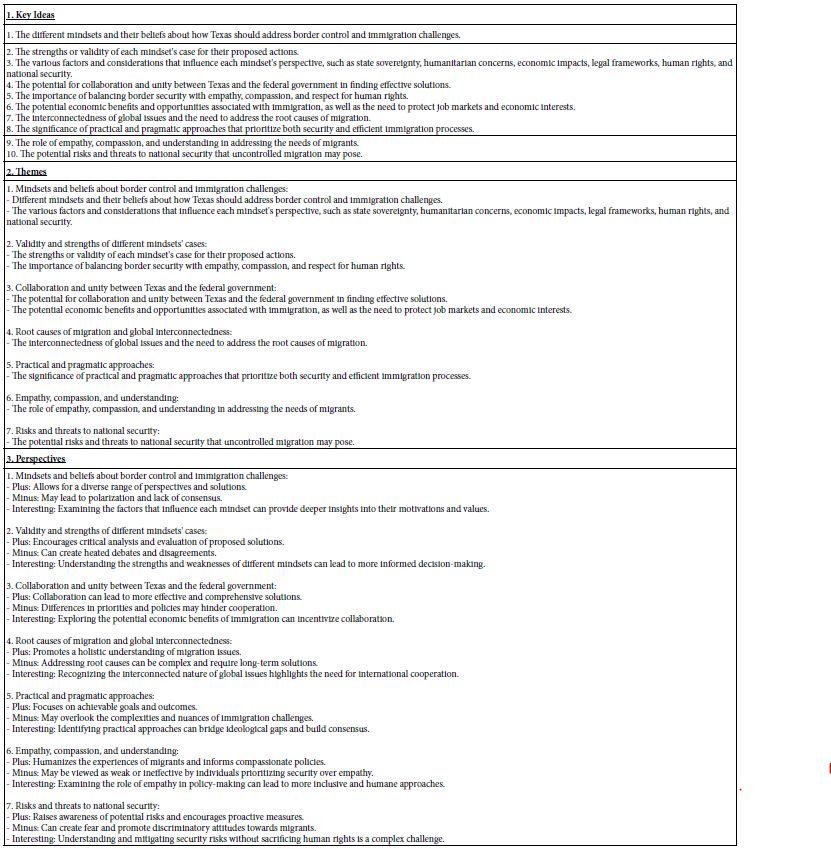
Third Set of Summarizations – What is Missing, and Suggestion for Innovation
The objective of this third set of summarizations revolves around using Mind Genomics and Idea Coach to drive innovation. The reality of having AI suggest both what is missing, and design innovations becomes the capstone of the effort. The sheer richness of information in Table 5 is remarkable, especially recognizing that the AI embedded in Idea Coach was given no starting information. Rather, it is simple the repeated summarizations emerging from one ‘briefing’ to the AI (Table 1) which generated this set of suggestions for innovation. Of course, the suggestions must be vetted for feasibility, and tested for acceptance by people.
Table 5: The search for ‘what is next’. The top of Table 5 shows what’s missing. The bottom shows the AI suggestion for innovative ideas.
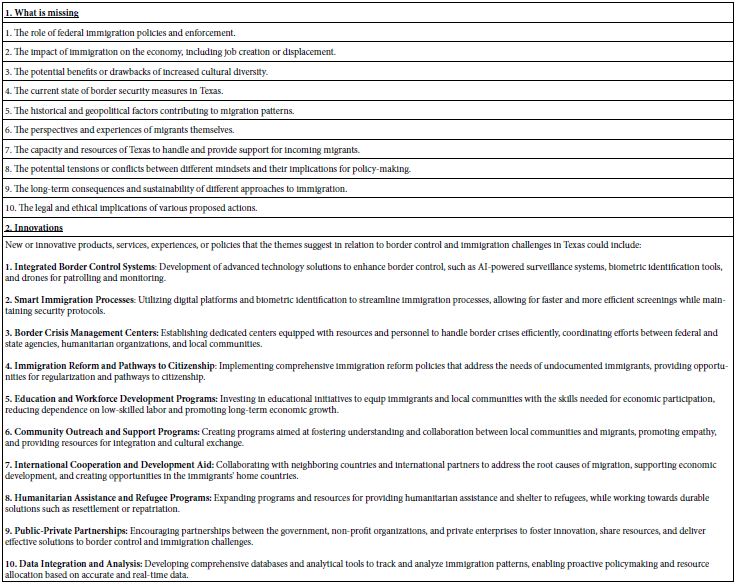
Discussion and Conclusions
The project reported here represents what one can accomplish with today’s AI, specifically the AI embedded within the Mind Genomics platform, www.bimileap.com. The simple approach of presenting a current issue and the plethora of information, suggestions, directions, and so forth becomes ever more remarkable when one realizes the simplicity of execution. The issue no longer becomes the ability to sit in a room of experts who have developed an understanding of the situation, that understanding coming after years of involvement, that understanding being the possession of the few, and of course in the world of homo economicus, that understanding coming at a high price tag. Rather, knowledge, direction, opportunity now lie at the hands of amateurs, those who are to inherit the future, rather than to profit from their experience. To end this paper, it is important to recognize that one can do the type of work here for virtually any topic where the mind of people is the driving force. The opportunity is to create a massive database of the mind, dealing with hundreds or even thousands of topics, these topics being general issues facing people, or being specific issues facing just a few people. One can only imagine what will happen to a world where anyone, anywhere can avail themselves of this technology as part of their education, even at the level of an elementary school student (see Mendoza et. al., 2023). The future in that world remains to unfold, but the tools are already here.
References
- Correa JG, Thomas JM (2024) “It’s my home, not a war zone”: It’s my home, not a war zone”: Mobilizing a multitude to demilitarize the Texas Rio Grande Valley. Sociology Compass 18(1): e13093.
- Glover A (2024) It’s my home, not a war zone”: Mobilizing a multitude to demilitarize the Texas Rio Grande Valley: Confronting Trump’s Reign of Terror, p. 379.
- Gonzalez V (2024) From Texas v. United States to United States v. Texas: The Increasing Influence of State Attorneys General on Federal Immigration Policy Through the Strategically Offensive Use of State Standing Doctrine. UCLA: New Perspectives.
- Hallett N (2024) The border’s migration. In: University of Chicago Legal Forum, Vol. 2023, No. 1, p.6.
- Reid D (2024) The Rise of Legislat,ive Intervention, the Fall of the Duty to Defend, and the Problems Thereinfor the State Attorneys General. UCLA: New Perspectives. Retrieved from
- Simmons B (2024) International Borders: Yours, Mine, and Ours. In University of Chicago Legal Forum 2023, No. 1, p. 10.
- Moskowitz HR (2012) ‘Mind genomics’: The experimental, inductive science of the ordinary, and its application to aspects of food and feeding. Physiology & Behavior 107: 606-613. [crossref]
- Moskowitz HR, Gofman A (2007) Selling Blue Elephants: How to Make Great Products That People Want Before They Even Know They Want Them. Pearson Education.
- Moskowitz HR, Wren J, Papajorgji P (2020) Mind Genomics and the Law. LAP LAMBERT Academic Publishing.
- Mendoza CL, Mendoza CI, Rappaport S, Deitel J, Moskowitz H, et al. (2023) Empowering young people to become researchers: What do people think about the different factors involved when shopping for food? Nutrition Research and Food Science Journal 1: 1-9.
- Gabay G, Gere A, Zemel G, Moskowitz H (2022) Personalized communication with patients at the emergency department—An experimental design study. Journal of Personalized Medicine 12: 1542. [crossref]
- Moskowitz HR, Martin D (1993) How computer aided design and presentation of concepts speeds up the product development process. In ESOMAR Marketing Research Congress (pp. 405-405). ESOMAR.
- Zemel R, Choudhuri SG, Gere A, Upreti H, Deitel Y, Papajorgji P, Moskowitz H, et al. (2020) Mind, consumers, and dairy: Applying artificial intelligence, Mind Genomics, and predictive viewpoint typing. In: Current Issues and Challenges in the Dairy Industry 2019 May 24 (ed: S.A. Ibrahim, T. Zimmerman, R. Gyawali). Intech Open IBSN: 9781789843569,
- Open AI (2023) https://beta.openai.com/docs/models/gpt-3, accessed January 18, 2023.